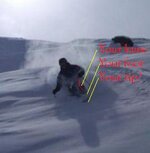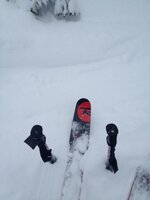abc
Well-known member
up
Everything you say about narrow waist skis still applies to fat skis. But rocker does change how a ski behave IN powder.
You can also put rocker on narrow skis too. But the market doesn't support it because everyone THINK fat is what's needed in powder. On the other hand, rockers ARE being added to some midfat "all mountain" skis, and work just as well.
A lot of people likes fat skis is because it can offer the same surface area in shorter length, making it easier to turn.
You're mixing rocker with width.Would you agree that there is no way you're going to carve a turn if you don't flex the ski into an arc?
Pull a ski from the quiver and flex it using a hand to support the tip and the floor to support the tail. Remember you have to flex the ski beyond the center line to where the binding is now on the opposite side of the natural arc. Take notice of how much force is on the hand (tip) and the floor (tail) to make this happen. It should be quite obvious that in fluffy powder you are not going to get the kind of back pressure needed to flex the ski. If not, the next test will prove it but likely make one hell of a mess. Take the ski to a full bathtub. Using all your weight at the binding, push the ski horizontally from floating on top of the tub to striking the bottom of the tub. The tip and tail of the ski will always hit the bottom of the tub first (no flex). Water actually offers more resistance than snow so this proves that there is no way you can flex a traditional ski enough to carve on or in powder. You don't have to do this test with a tip and tail rocker ski because it is already flexed into the proper (turning) arc by design.
So the only way you're carving turns with traditional 68mm skis is that you are in contact with the groomed base underneath and flexing the ski on that groomed base layer. Basically skiing like it's a groomed trail with the nuisance of ungroomed snow in your way. This may be fine for you but there is no float or feeling of weightlessness which many feel to be the biggest draw to powder skiing in the first place.
Fat rocker skis allow me to float in the middle of the powder while carving and skidding. Methods of leaning back and wagging the tips or bouncing to initiate turns are tossed in the trash and are replaced with the shape ski technique of railroading. Railroading only works with a flexed ski.
Note: I believe there's a new term for skidding in this months issue of Ski Magazine. I wish I could remember it as it's a good example of something that wasn't possible before the new technology in skis today.
Everything you say about narrow waist skis still applies to fat skis. But rocker does change how a ski behave IN powder.
You can also put rocker on narrow skis too. But the market doesn't support it because everyone THINK fat is what's needed in powder. On the other hand, rockers ARE being added to some midfat "all mountain" skis, and work just as well.
A lot of people likes fat skis is because it can offer the same surface area in shorter length, making it easier to turn.

